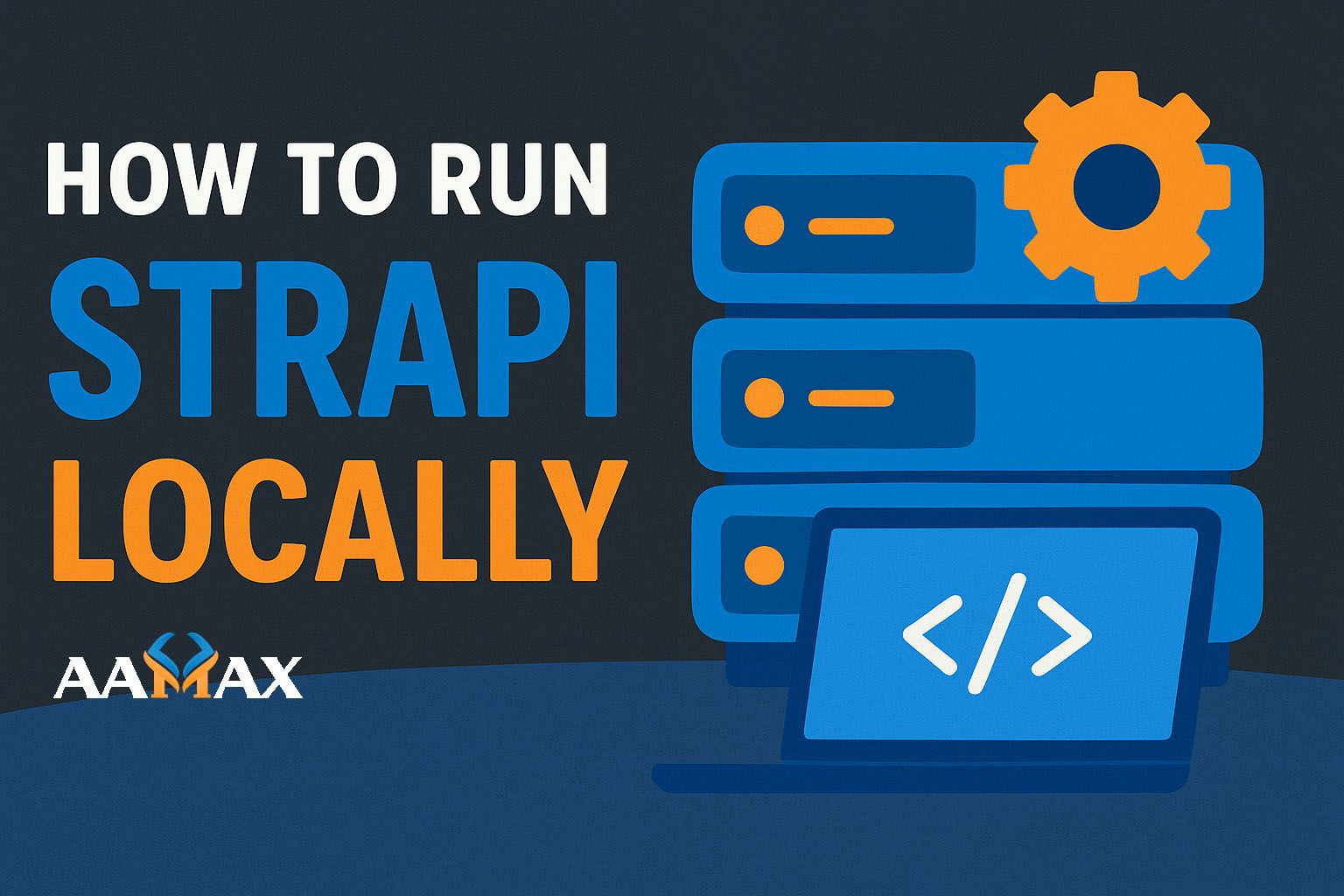
How to Run Strapi Locally
Running Strapi locally is one of the best ways to build, test, and customize your backend before deploying it to production. Whether you're developing a MERN stack application, creating a custom API, or building a headless CMS for a modern frontend framework, Strapi provides an extremely developer-friendly environment. This guide explains in detail how to run Strapi locally, the steps, prerequisites, commands, troubleshooting, and best practices you should follow for a smooth development workflow.
If you need professional help with Strapi, MERN Stack, or full-stack development, you can hire AAMAX --- a full-service digital marketing and development company offering MERN Stack Development, Web Development, Digital Marketing, and SEO Services.
What Is Strapi?
Strapi is an open-source, Node.js-based headless CMS that allows developers to create content-rich applications with ease. Unlike traditional monolithic CMS platforms, Strapi provides a decoupled architecture, enabling developers to build frontends using React, Next.js, Vue, Angular, mobile frameworks, or even IoT applications while Strapi handles backend logic and content management.
Key Features of Strapi
- Fully customizable backend\
- REST and GraphQL APIs\
- Admin panel for content editors\
- Supports SQL and NoSQL databases\
- Extensible plugin ecosystem\
- Self-hosted for full data ownership\
- Fast development with auto-generated endpoints
These features make Strapi ideal for MERN applications, enterprise dashboards, high-traffic websites, and SaaS platforms.
Why Run Strapi Locally?
Running Strapi locally allows developers to:
- Prototype new features quickly\
- Test content models without affecting production\
- Debug backend logic and API responses\
- Integrate Strapi with React/Next.js during development\
- Experiment with plugins and custom code\
- Build secure and optimized backend configurations
Whether you're working solo or in a team, a local Strapi setup ensures smooth and flexible development.
Prerequisites for Running Strapi Locally
Before running Strapi, your system should meet the following requirements.
1. Node.js
Strapi supports:
- Node.js v18 or later
Check your version:
node -v
If you need to upgrade Node.js, download it from the official website or
use nvm.
2. npm or yarn
Strapi works with either:
npm -v
yarn -v
Most developers use npm, but yarn is also an excellent choice due to faster installation speeds.
3. Database (Optional for Development)
Strapi supports:
- SQLite (default in quickstart)
- PostgreSQL
- MongoDB
- MySQL
- MariaDB
For running Strapi locally, SQLite is recommended because it requires no setup.
4. Git (Optional but useful)
If you're cloning a project from a repository, Git is needed.
5. Code Editor
VS Code is preferred due to plugin support and integrated terminal.
Creating a New Strapi Project Locally
You can create a brand-new Strapi project using either npm or yarn.
Using npm:
npx create-strapi-app@latest my-project
Using yarn:
yarn create strapi-app my-project
Strapi will ask if you want:
- Quickstart with SQLite
- Custom setup with your choice of database
If you are creating a local environment, select Quickstart.
Running an Existing Strapi Project Locally
If you're working on a cloned project:
Step 1: Clone the repository
git clone <your-repo-url>
cd your-project-folder
Step 2: Install dependencies
npm install
or
yarn install
Step 3: Create a .env file (if required)
Some Strapi projects include environment-specific settings. If the
project requires an .env file, create one:
cp .env.example .env
Then update environment variables accordingly.
How to Run Strapi Locally in Development Mode
Running Strapi locally is simple once dependencies are installed.
Step 1: Start the development server
Using npm:
npm run develop
Using yarn:
yarn develop
Development mode:
- Enables hot reload\
- Compiles admin panel\
- Logs database activity\
- Allows live editing
Step 2: Access the Strapi Admin Panel
Open:
http://localhost:1337/admin
If this is the first run, you'll be prompted to create an admin user.
Step 3: Test API Endpoints
Strapi automatically generates REST API endpoints for each collection type.
Example:
http://localhost:1337/api/posts
If GraphQL plugin is installed:
http://localhost:1337/graphql
Step 4: Use Strapi with a Frontend (React, Next.js, Vue)
For MERN Stack developers, you can connect your local Strapi backend with a frontend app:
Example (React):
fetch("http://localhost:1337/api/posts")
.then(res => res.json())
.then(data => console.log(data));
This allows seamless integration between frontend and backend.
Running Strapi in Production Mode Locally
Sometimes developers test production build locally before deployment.
Step 1: Build the admin panel
npm run build
or:
yarn build
Step 2: Start Strapi in production mode
npm run start
or:
yarn start
Production mode:
- Improves performance\
- Disables hot reloading\
- Loads production environment settings
Understanding the Strapi Folder Structure
A typical Strapi project contains:
/src
/api
/components
/extensions
/config
/public
package.json
.env
Important Folders Explained
src/api
Contains APIs, including controllers, services, and models.
src/components
Reusable structured content components.
config
Houses server settings, routes, middlewares, and database configurations.
public
Static files accessible to all users.
Understanding this structure is essential for customizing your Strapi backend locally.
Managing Environment Variables in Local Development
Strapi heavily relies on environment variables for:
- Database configurations\
- Tokens & secrets\
- SMTP credentials\
- Cloud storage keys
Example .env file:
APP_KEYS=key1,key2
API_TOKEN_SALT=abcd1234
DATABASE_CLIENT=sqlite
HOST=0.0.0.0
PORT=1337
Use env("VARIABLE") inside configuration files.
Running Strapi with PM2 Locally
PM2 is a process manager used mostly in production, but you can also use it locally for testing.
npm install pm2 -g
pm2 start npm --name "strapi-local" -- run develop
Check logs:
pm2 logs
Stop:
pm2 stop strapi-local
Running Strapi Locally with Docker
If you prefer Docker-based development:
Step 1: Create a Dockerfile
FROM node:18
WORKDIR /app
COPY package*.json ./
RUN npm install
COPY . .
EXPOSE 1337
CMD ["npm", "run", "develop"]
Step 2: Build the image
docker build -t strapi-local .
Step 3: Run the container
docker run -p 1337:1337 strapi-local
Common Issues When Running Strapi Locally
1. Admin Panel Build Failure
Fix:
rm -rf .cache build
npm run develop
2. Database Connection Error
Check:
- Wrong credentials\
- Database server not running\
- Incorrect ports
3. Module Not Found
Fix:
rm -rf node_modules
npm install
4. CORS Errors When Connecting from Frontend
Add this inside config/middlewares.js:
module.exports = [
'strapi::errors',
{
name: 'strapi::cors',
config: {
enabled: true,
headers: '*',
origin: ['http://localhost:3000']
}
},
];
Best Practices for Running Strapi Locally
- Keep Node.js updated\
- Use SQLite for local development\
- Restart Strapi after updating configuration files\
- Use version control for API changes\
- Backup your database regularly\
- Use
.envfiles for sensitive data\ - Use separate environments for dev, staging, and production\
- Test custom plugins locally before deployment
Why Choose AAMAX for MERN & Strapi Development?
Strapi is powerful, but building production-ready applications requires experience. AAMAX specializes in:
- MERN Stack Development\
- Custom API development\
- Scalable backend architecture\
- Digital marketing integrations\
- SEO-friendly web development\
- Full-service enterprise solutions
From concept to deployment, AAMAX ensures your Strapi projects are optimized, secure, and highly scalable.
Final Thoughts
Running Strapi locally is the foundation of modern backend development. With the steps provided in this guide, you now know how to:
- Install and configure Strapi\
- Run it in development and production modes\
- Use Strapi with frontends like React and Next.js\
- Manage environments and troubleshoot errors\
- Optimize your workflow
Strapi makes backend development efficient and enjoyable, and with a strong local development setup, you can build powerful digital products with ease.
If your business needs expert assistance, don't hesitate to collaborate with AAMAX for professional Strapi and MERN development services.







